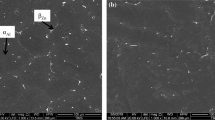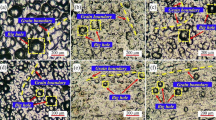Abstract
The experiments focused on the influence of magnesium and titanium as additional alloying elements on the microstructure and electrochemical behavior of Al-Zn-In sacrificial anodes. The electrochemical behavior of the aluminum sacrificial anode with 3 wt.% sodium chloride solution was studied by electrochemical impedance spectroscopy (EIS) tests. It was found that a microstructure with few precipitates and refined grains could be achieved by adding 1 wt.% Mg and 0.05 wt.% Ti to the Al-Zn-In alloy, resulting in the improved current capacity and efficiency of the alloy. The equivalent circuit based on the EIS experimental data revealed less corrosion and lower adsorbed corrosion production on the surface of the aluminum alloy with a combination of 1 wt.% Mg and 0.05 wt.% Ti, which suggested that the corrosion behavior seemed to be strongly related to the presence of precipitate particles in the aluminum alloy, and moderate amounts of precipitate particles could be beneficial to the electrochemical performance of the aluminum alloy sacrificial anode.
Similar content being viewed by others
References
Saidman S.B. and Bessone J.B., Cathodic polarization characteristics and activation of aluminum in chloride solutions containing indium and zinc ions, J. Appl. Electrochem., 1997, 27(6): 731.
Bessone J.B., The activation of aluminum by mercury ions in non-aggressive media, Corros. Sci., 2006, 48(5): 4243.
Munoz A.G., Saidman S.B., and Bessone J.B., Corrosion of an Al-Zn-In alloy in chloride media, Corros. Sci., 2002, 44 (2):2171.
Bessone J.B., Flamini D.O., and Saidman S.B., Comprehensive model for the activation mechanism of Al-Zn alloys produced by indium, Corros. Sci., 2005, 47(3): 256.
Ma J.L., Wen J.B., Li X.D., Li G.F., Jiao M.W., and Guo W., Effect of heat treatment on microstructure and electrochemical performance of Al-Zn-In-Mg-Ti alloy, Trans. Mater. Heat Treatment (in Chinese), 2008, 29(3): 113.
Sina H., Emamya M., and Saremi M., The influence of Ti and Zr on electrochemical properties of aluminum sacrificial anodes, Mater. Sci. Eng. A, 2006, 431(4): 263.
GB/T17848-1999, Test Methods for Electrochemical Properties of Sacrificial Anodes (in Chinese), China Standard Press, Beijing, 2002.
Shibli S.M. and Gireesh V.S., Activation of aluminum alloy sacrificial anodes by selenium, Corros. Sci., 2005, 47(9): 2091.
Alves V.A. and Brett C.M.A., Characterisation of passive films formed on mild steels in bicarbonate solution by EIS, Electrochim. Acta, 2002, 47(10): 2081.
Zhang S.S. and Jow T.R., Aluminum corrosion in electrolyte of Li-ion battery, J. Power Sources, 2002, 109(3): 458.
Cao C.N. and Zhang J.Q., An Introduction to Electrochemical Impedance Spectroscopy (in Chinese), Science Press, Beijing, 2004.
Author information
Authors and Affiliations
Corresponding author
Rights and permissions
About this article
Cite this article
Ma, J., Wen, J., Li, X. et al. Influence of Mg and Ti on the microstructure and electrochemical performance of aluminum alloy sacrificial anodes. Rare Metals 28, 187–192 (2009). https://doi.org/10.1007/s12598-009-0037-z
Received:
Revised:
Accepted:
Published:
Issue Date:
DOI: https://doi.org/10.1007/s12598-009-0037-z




